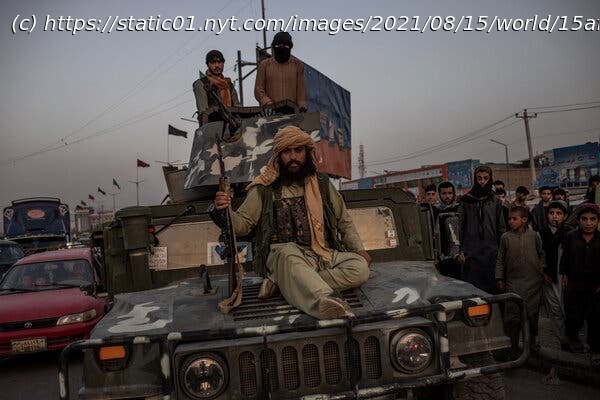A takeover of the entire country was all but absolute as the Afghan government collapsed and the U.S. rushed through a frenzied evacuation.
Taliban fighters poured into the Afghan capital on Sunday amid scenes of panic and chaos, bringing a swift and shocking close to the Afghan government and the 20-year American era in the country. President Ashraf Ghani of Afghanistan fled the country, and a council of Afghan officials, including former President Hamid Karzai, said they would open negotiations with the Taliban over the shape of the insurgency’s takeover. By day’s end, the insurgents had all but officially sealed their control of the entire country. The speed and violence of the Taliban sweep through the countryside and cities the previous week caught the American military and government flat-footed. Hastily arranged American military helicopter flights evacuated the sprawling American Embassy compound in Kabul, ferrying American diplomats and Afghan Embassy workers to the Kabul military airport. At the civilian airport next door, Afghans wept as they begged airline workers to put their families on outbound commercial flights even as most were grounded in favor of military aircraft. Amid occasional bursts of gunfire, the whump of American Chinook and Black Hawk helicopters overhead drowned out the thrum of traffic as the frenzied evacuation effort unfolded. Below, Kabul’s streets were jammed with vehicles as panic set off a race to leave the city. Two decades after American troops invaded Afghanistan to root out Qaeda terrorists who attacked on Sept.11,2001, the American nation-building experiment was in ruins — undercut by misguided and often contradictory policies and by a relentless insurgency whose staying power had been profoundly underestimated by U.S. military planners. More than 2,400 American troops gave their lives and thousands more were wounded in an effort to build a democratic Afghan government. Tens of thousands of civilians died in the fighting, and thousands more were displaced from their homes. In recent days alone, thousands fled to Kabul as the Taliban advanced through other cities at breakneck speed. The toll of war fell heavily on Afghan armed forces in recent years. But no amount of American training and matériel — at a cost of $83 billion — was sufficient to create a security force willing to fight and die for a besieged nation that American forces were leaving behind. Public declarations by, first, President Donald J. Trump and then President Biden calling for a quick and total troop pullout sent morale plummeting across Afghanistan. In Washington, the speed of the collapse took the Biden administration by surprise, officials said — and left it with the realization that Mr. Biden will go down in history as the president who presided over a humiliating final act in a long and bedeviled American chapter in Afghanistan. Now, Afghans suddenly face the prospect of complete domination by the Taliban again. In areas the insurgents have recently conquered, there is no sign they have turned away from the harsh Islamist code and rule by intimidation that characterized their government in the 1990s. In the center of Kabul, people began painting over advertisements and posters of women at beauty salons, already fearing the return of the Taliban’s traditional bans against images of humans and against women appearing in public unveiled. Inside the vacated presidential palace, Al Jazeera broadcast what the network described as a news briefing delivered by Taliban commanders flanked by fighters with assault weapons. The network quoted the fighters as saying they were working to secure Kabul so that leaders in Qatar and outside the capital could return safely. At 6:30 p.m., the Taliban issued a statement that their forces were moving into police districts in order to maintain security in areas that had been abandoned by the government security forces.






